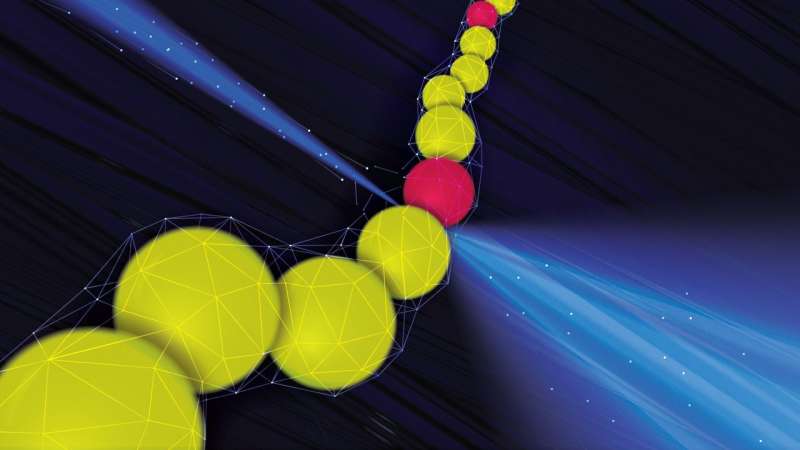World's smallest sensor measures growth force of plants, animals and humans

How do you visualise the extremely small forces connected to processes such as embryonic growth and development? Researchers at Wageningen have experimented with a combination of laser technology and chemistry, coming up with a sensor consisting of one single molecule that is a few hundred times more accurate than existing devices used to measure nano-forces on the molecular level. The researchers describe their findings in the 18 January issue of the scientific journal Chem.
The forces experienced by molecules in cells, but also in all the materials around us, are so small that even the most accurate existing measuring devices are barely able to detect whether it is a force at all. "Until now, everything was black or white, either there was a force or there wasn't—existing methods couldn't determine anything in between," says Joris Sprakel, research group leader at Sprakel Lab and the Physical Chemistry and Soft Matter Group of Wageningen University & Research. "With a team of three young researchers and an advanced student we've brought together various areas of expertise. And we came up with the idea that it had to be theoretically possible to detect the forces at molecular level by using the molecule itself as a nano measuring device. We no longer measure black or white, but 'fifty shades of grey' so to speak."
Expressed in technical terms, sensing the force of one molecule has a resolution of 100 femtonewtons. As a force, this is written as 0.0000000000001 newton (1 newton feels like around 100 grams). "But a molecule is also unbelievably small, about one nanometre, or one millionth of a millimetre," says Joris Sprakel. "This force of one hundred femtonewtons that presses on a molecule of one nanometre can be compared with the force of a grain of sand on a person's shoulder. And we can measure such small forces with the relationships that are a billion times smaller."
Using the new measuring method, the researchers gained more insight into the forces that are active on a molecular level in the living cells of plants, animals and humans. "For example, in the embryonic development of plant cells, we know that miniscule forces determine when a cell divides and in which direction. So ultimately, these mechanical stimuli determine how the plant embryo develops, but until now it wasn't possible to measure this," says Sprakel. "Previously, we had no direct access to physical phenomena on this scale, and if you can't see it, it's almost impossible to understand how it works. If you understand the role of nano-forces in biological processes, in the long term, it may be possible to prevent certain diseases due to errors in these cell forces. But this is still something for the future; we've now demonstrated how we can measure these kinds of 'unmeasurable' forces. In my team, we are currently working on applying this approach to cellular processes."
Molecule as measuring device
According to Joris Sprakel, taking these kinds of sensitive, small-scale measurements are not possible using a large measuring device in a cell. The researchers therefore created molecules that act as measuring devices. Each of the molecular sensors made by the team works as a nano-force metre. To measure the molecule and determine the force, the researchers shine a laser on one molecule. This molecule returns the light in a different shade, allowing the research team to determine the amount of force. Crucially, therefore, the method does not only consist of a new molecule or a new instrument, but of a combination of the two.
"We needed a strong interdisciplinary team for this," says Sprakel. "This breakthrough was achieved by the unique combination of four young researchers in my team, each with their own area of expertise. It meant we were finally able to realise this long-cherished dream."
More information: Ties van de Laar et al. Light from Within: Sensing Weak Strains and FemtoNewton Forces in Single Molecules, Chem (2018). DOI: 10.1016/j.chempr.2017.12.016
Journal information: Chem
Provided by Wageningen University





















